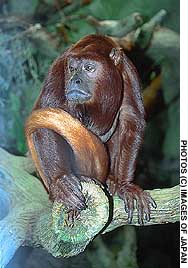Puzzling over monkeys' many ways of life
By Mark Brazil | May 30, 2002
PRIMATESIt was a faint and far-off sound, barely audible, like the distant rumbling of thunder. Something about it triggered memories, and I asked skipper Mike to cut our outboard motor. Even with the engine off and my hands cupped behind my ears, head turning like a radar dish, I was still not absolutely sure.
Had I imagined it? Then I heard it again, stronger this time, still distant but definitely a deep guttural roaring.
Switching to our virtually silent electric motor, we puttered slowly downstream in search of the invisible roarers lurking behind the wall of dense jungle overhanging this tributary of the Brazilian Amazon. The calls were clearer now, distinct, yet the callers themselves remained tantalizingly hidden. Several male primates were choosing dawn to announce their presence to any nearby groups. These were red howler monkeys.
Howlers spend most of their lives in the forest canopy where, because of the many dense layers of vegetation in between, it is almost impossible to see them from the ground. All those leaf layers also act as very effective sound baffles, reducing the extent to which it travels. Marmosets and tamarins, the tiny implike monkeys of South America, have high-pitched twittering, birdlike calls, but many other New World primate groups seem largely silent, except at close range.
The red howlers though, have developed an astonishing guttural call. They have also evolved a strange bony throat pouch, an enlarged, hollow hyoid bone capable of amplifying their throaty roars so they carry across the forest for more than a kilometer. This inbuilt soundbox resonates their guttural calls, making their roars a familiar feature of Central and South American tropical forest dawns. Despite the extent of their amplification, I have found that I notice the howlers’ calls more readily when I am on a river, perhaps because they prefer riverine forest, or perhaps because their calls travel farther across open water.
The roar is an eerie sound, as deep as someone clearing their throat before a cough, but continuous and impossible to pin down to an individual. It seems ventriloquial, and perhaps that is to their benefit. The loudness of it is sufficient to warn other troupes of their occupation of a forest area, but not so specifically directional as to give away their exact location to potential predators.
Research on red deer in Scotland, another species with a deep bellowing roar (but only during the autumn rutting season), has shown that roaring has a and considerable energy cost. Among deer, that cost is balanced by the greater chance of stags achieving mating rights over a harem of does. Among red howlers, perhaps the reason they mainly tend to call at dawn is that in the cooler air, they are able to attain maximum advertising benefit at minimum energy cost.
It is not only their calls, however, that make the red howlers unusual. Among the South American primates, they are one of very few species that will eat mature leaves. Leaves are a low-energy food source, so not surprisingly the howlers spend much of their day just eating.
Compared with the long-range vocal communication of South American howlers, the interactions of Japanese macaques, found from southern Kyushu to northern Honshu, are at much closer range, more “in your face.” In fact, many of their interactions include strong facial expressions. However, if you ever find yourself in close proximity to Japanese macaques, be sure not to look them in the eye as this will be interpreted as aggression and may provoke a threat reaction involving an alarming baring of teeth. That may be manageable if you have accidentally intimidated a small female or a young male — but if you’ve upset a larger animal, you may find yourself on the sharp end of the dentition of this Old World primate.
In contrast to the macaques here, you are very unlikely to encounter a howler face to face, as they live high above the ground. Their faces, though, are far less expressive than those of Old World macaques.
It’s interesting to note, but hard to explain, why the monkeys of South America are so different from those of Africa or Asia. Immense periods of time in isolation is probably the key, combined with differences in their environments, their competitors and their predators.
Here in Japan, the macaques reveal two features unique to Old World monkeys, one being that they spend much of their lives in groups on the ground. Even though youngsters frequently play in the trees and adults choose trees to shelter and sleep in, Japan’s macaques are essentially terrestrial, foraging and interacting beneath the trees of their forested home.
Travel to Africa and you’ll find baboons taking the terrestrial lifestyle to extremes with, among the great apes, chimpanzees, bonobo (formerly known as pygmy chimpanzees), lowland and mountain gorillas also spending most of their daily lives on the ground. Only the orangutan (the only great ape of Asia, native to Borneo and Sumatra) is habitually arboreal, and for it, the ground is a place to visit, but not to stay. For the others, it is the other way round.
Homo sapiens, of course, take life on the ground to extremes, though even in our species tree-climbing is far more common among the young, particularly pre-pubescent and adolescent males, than among females or older individuals.
The great apes, and the lesser apes (a group including the most arboreal of all monkeys, the high-speed brachiating gibbons and siamangs), share another feature with the Japanese macaque — they are all tailless primates, just like us, but unlike the monkeys of South America, which all have tails.
What’s so unusual about that, you may ask? Don’t lots of other monkeys have tails? Indeed they do. Visit Indonesia and see crab-eating macaques, go to India and see langurs, Africa to see patas or colobus monkeys or the New World tropics to see tiny squirrel monkeys and you cannot fail to notice their long tails. They are conspicuous and elegant, flaring out behind them as they leap from branch to branch.
If you watch squirrels, you will see similar movements. Their tails seem to operate as aerial stabilizers and rudders to assist in high-speed jumping. Try throwing a sewing needle at a target, then thread a short piece of sewing cotton through the eye and try again. The presence of the “tail” keeps the needle straight and on target. Perhaps the tails of squirrels, and Asian and African monkeys, serve much the same purpose.
Make the same close-up observations of South American monkeys such as the capuchin monkeys, and you will soon notice that their tails are in motion much of the time, being draped and drawn over branches as if they are stroking things with them. The tails of these monkeys are extraordinary in their dexterity.
Many of the South American species (but not the squirrel monkey) have a truly prehensile tail that they use as a fifth limb. I have watched members of various species wrap a tail around a branch, reach out with their arms to feed on fruit or young leaves, and ultimately let go with their legs, dangling just by their tail. The merely rudderlike tail of an African or Asian monkey cannot be used in this way.
The howler monkeys of central and South America are not only tailed, but like all their relatives, they are arboreal. Just why none of the South American primates has adapted to life on the ground is not known, but it marks them out as very different from their distant relatives in Africa and Asia.


